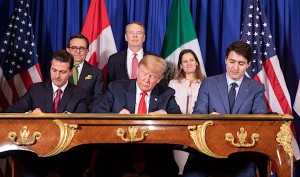
The leaders of Mexico, the United States and Canada sign the “new” NAFTA earlier this year. The new deal is expected to cost automakers $3 billion more in tariffs.
The long-awaited revamp of the North American Free Trade Agreement was passed by the U.S. Senate Thursday, and now heads to the desk of President Donald Trump for his approval.
The new deal between the U.S., Mexico and Canada, which Trump has dubbed the United States-Mexico-Canada Trade Agreement, or USMCA, was a centerpiece of the president’s campaign in 2016. He frequently criticized NAFTA, saying it was a bad deal and promised to renegotiate it or simply stop abiding by it all together.
The new deal passed on an 89-10 bipartisan vote. The U.S. House of Representatives passed the legislation Dec. 19 by a vote of 385 to 41, after the Trump administration had completed talks earlier this year.
(Automakers likely to pay out more $3B more in tariffs under USMCA)
While the president and leaders of both houses crowed about getting the deal done, with descriptions ranging from “a far better deal” to “modestly better,” the auto companies that pushed for an updated deal may not be getting what they’d hoped for exactly.
Now that it’s basically done – it awaits only the president’s signature – automakers that had been pushing for its completion so they could get the certainty they crave in their business, will pay nearly $3 billion more in tariffs as a result of the higher content rules set forth in the new version of NAFTA.
The lofty figure comes from an estimate by the non-partisan Congressional Budget Office developed to determine how much it will cost to implement legislation to meet the rules on the deal, assuming Trump doesn’t suddenly do an about face on his own deal.
(U.S. House passes updated USMCA – What does it mean for autos?)
For autos to receive tariff-free access between the three countries, the USMCA imposes a 75% regional content requirement, up from 62.5% in NAFTA, along with new mandates to use North American steel and aluminum, Reuters reported.
However, there additional provisions that may prove problematic, such as the mandate that 40% to 45% of vehicle content must come from high-wage areas paying more than $16 an hour. In short, this means the U.S. and Canada. Many vehicles from Mexico will not make the cut, and fail to qualify for U.S. tariff-free access.
The report’s authors noted their estimates assume that some vehicles and parts would not be eligible for USMCA’s tariff-free access.
“Because of that change in eligibility, CBO projects that duty-free imports of vehicles and parts into the United States from the USMCA partner countries would decline,” the agency said in the report.
(Automakers Renew Plea for Congress to Pass New NAFTA)
While it said a portion of those vehicles and parts would be replaced by U.S. production, some imports of non-USMCA-compliant vehicles and parts would continue, receiving less favorable treatment.
